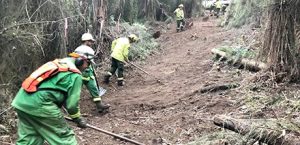One thing you can be certain of in the timber industry is that you would have experienced fire before. Some fires are worse than others and fires have significant impacts on the industry, whether it be plantation or native based. However, even if impacted upon, it does not mean the industry is over or the consequences will be irreparable. Source: Timberbiz
Forest industries in Queensland, NSW, Victoria, and South Australia have been impacted by the damage of timber-producing native forests and plantations in the recent catastrophic bushfires.
A huge bush fire recovery harvesting operation needs to occur over the coming weeks and months to recover as much of the burnt trees for timber as possible within environmental, safety and market constraints, before they deteriorate along with pest and diseases being a major risk for damaged and dying timber.
There is a narrow window of opportunity to undertake the necessary assessments and mapping of what can be harvested or ‘salvaged’, and coordinating the huge harvest and haulage operation required, so it is vital that Government and industry work together to ensure these operations occur in a timely manner and prepare the land for regeneration (in the case of native forests) and replanting (in the case of plantations).
It is anticipated that significant volumes of timber will be salvaged from the burnt softwood plantations in the NSW Southwest Slopes around Tumut, Tumbarumba and Bombala, as well as the native forest estate in NSW and Victoria.
It should be noted that the length of time that standing trees take to degrade and cannot then be recovered spans up to months for softwood plantation timber and up to a couple of years for durable native forest timber, due to the different timber characteristics and how badly burnt the trees are.
The recovery window may also have safety considerations with standing dead wood and dead crowns presenting a limb fall hazard.
Sawmill and processing recovery is generally lower and machine wear and tear higher for processing salvage timber, which means that there is a direct commercial and financial impact on wood processing businesses.
Beyond generating revenue, recovery harvesting of burnt trees sometimes referred to as ‘salvaging’ can also help manage fuels and future fire behaviour. Removal of hazardous standing dead fuel also contributes to firefighter safety.
Recovery harvesting can help reduce excess fuels and decrease the risk of subsequent high-severity bushfires. Converting dead or dying trees into carbon-storing forest products rather than allowing them to decompose in the forest or burn in future bushfires thereby releasing carbon emissions, also provide carbon storage benefits.
It is also important to remove and replant so that forest managers have the flexibility as soon as possible in the future to restore the forest age profile.
As soon as practicably possible, FTMA Australia will coordinate a tour of the Tumut and Tumbarumba regions where delegates can learn more about the salvage operations, the processing of salvaged timber, the impacts on our future resource and of course have the chance to network and thank those in the local communities for all they have done throughout the fires.








